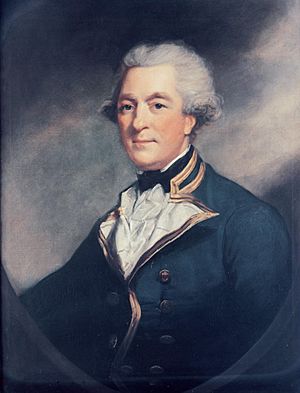Sir Andrew Hamond, 1st Baronet facts for kids
Quick facts for kids
Sir Andrew Hamond, Bt
|
|
|---|---|

Sir Andrew Hamond
|
|
| Born | 17 December 1738 Blackheath (London), England |
| Died | 12 September 1828 (aged 89) Terrington Clement, England |
| Allegiance | |
| Service/ |
|
| Rank | Captain |
| Commands held | Nore Command |
Sir Andrew Snape Hamond (born December 17, 1738 – died September 12, 1828) was an important British naval officer. He was also known as the 1st Baronet, which is a special title of honor. Sir Andrew served as the Lieutenant Governor of Nova Scotia from 1781 to 1782. This role meant he was in charge of the government in Nova Scotia, a part of Canada today. Later, he became the Comptroller of the Navy from 1794 until he passed away. This job meant he was responsible for managing the Royal Navy's finances and supplies.
Contents
Andrew Hamond was born in Blackheath, London, England. His parents were Robert Hamond and Susannah Snape. He joined the Royal Navy in 1753 when he was just 15 years old. He served during two major conflicts: the Seven Years' War and the American Revolution. These wars were very important for Britain.
Rising Through the Ranks
Andrew Hamond quickly showed his skills in the navy. In 1765, he was promoted to a commander. Just five years later, in 1770, he became a captain. This was a significant achievement for a naval officer.
Service in the American Revolution
During the American Revolution, Captain Hamond played a key role. He was in charge of the North American station during the Expedition to the Chesapeake (1777). He also commanded a warship during the defense of Sandy Hook in 1778. His bravery and leadership in this battle were recognized. Because of his actions, he was knighted, which means he received the title "Sir."
Leadership in Nova Scotia
In 1781, Sir Andrew Hamond was chosen to be the Lieutenant Governor of Nova Scotia. He took on this role when the previous governor, Francis Legge, had left. Hamond was responsible for leading the government in Nova Scotia during a challenging time.
Protecting Lunenburg
One important event during his time as governor was the Raid on Lunenburg, Nova Scotia (1782). When the town of Lunenburg was attacked, Hamond quickly ordered troops to stop the raid. His quick actions helped protect the people and the area.
Leaving the Governorship
Sir Andrew had hoped to become the permanent governor of Nova Scotia. However, John Parr was chosen for the position instead. Feeling disappointed, Hamond resigned from his role as lieutenant governor soon after Parr arrived. Even after leaving this position, he continued to serve as the Resident Commissioner of the Navy in Halifax, Nova Scotia, from 1780 to 1784.
Later Career and Achievements
In 1783, Sir Andrew Hamond received another honor: he was awarded a baronetcy. This meant he was given the title "1st Baronet," which could be passed down in his family.
He continued his impressive career in the navy. In 1785, he became the Commander-in-Chief, The Nore. This was a very important command position. From 1794 until his death, he served as the Comptroller of the Navy. In this role, he managed the Royal Navy's budget, supplies, and ship construction. He also helped with the court-martial of sailors involved in the famous Mutiny on the Bounty.
Political Life and Recognition
From 1796 to 1806, Sir Andrew Hamond was a Member of Parliament for Ipswich. This meant he helped make laws for the country. In 1797, he was elected a Fellow of the Royal Society. This is a prestigious honor for people who have made important contributions to science.
Legacy and Namesakes
Sir Andrew Hamond left a lasting mark, with several places and things named in his honor.
- Hammonds Plains: Settlers in a new area outside Halifax, Nova Scotia, decided to name their community Hammonds Plains after the popular Lieutenant Governor.
- Lady Hammond Road: A new main road built by Hamond, leading out of Halifax, was named the Lady Hammond Road. It was named after his wife, Cecilia.
- Geographical Features: Cape Hamond in Alaska, now known as Cape Saint Elias, was also named for him. The Hammond River in New Brunswick, Canada, also bears his name.
- Ship: A ship built in 1800 was named Sir Andrew Hammond (1800 ship) in his honor.
Family Life
Sir Andrew Hamond was married twice. His first marriage was to Cecilia Sutherland in April 1763. They did not have any children. He later married Anne Graeme in March 1779. With Anne, he had two children: a son, Admiral of the Fleet Sir Graham Hamond, 2nd Baronet, who also became a distinguished naval officer, and a daughter, Caroline Hamond.

